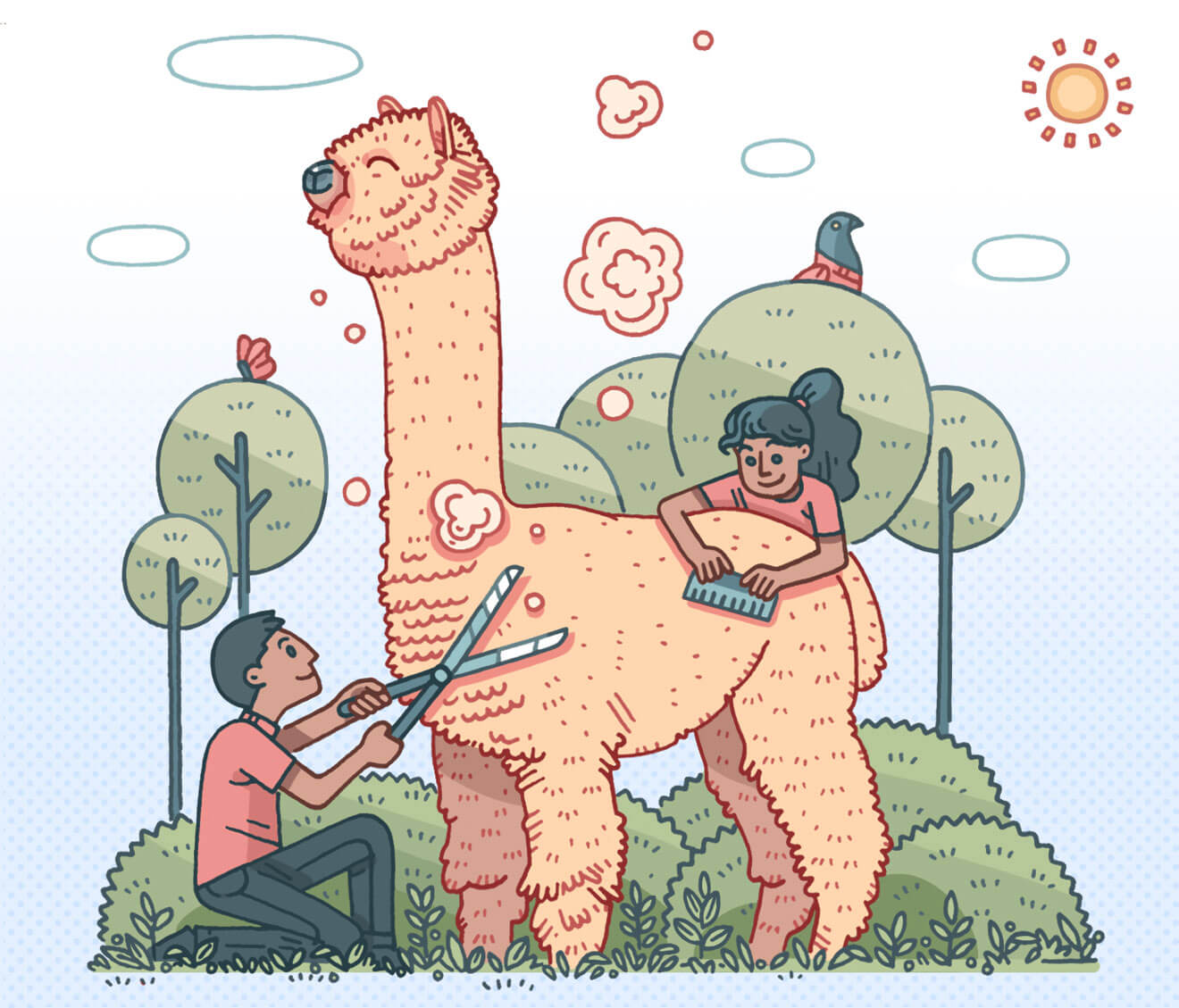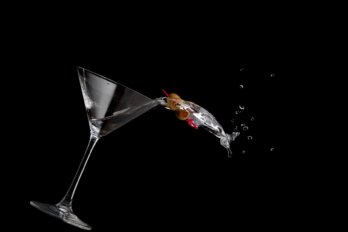Few things about British country life are more certain than finding a sprinkling of sheep on a pasture. But, if you’re lucky, those furry dots bouncing toward you will reveal themselves to be not Cheviot rams or Romney ewes but Huacaya and Suri alpacas. Likely, their top-heavy forms will circle you curiously, ears perked, necks angling forward as if to steal a kiss.
This is the scene I recently wandered into at Bozedown Farm, in Oxfordshire, before holding court to dozens of four-foot shag-pile wonders, lips curved upward in apparent smiles. They looked less like camelids than like Muppets or something Matt Groening might doodle on a greeting card. An hour surrounded by alpacas is like a month on Prozac, yet the cuteness of the alpaca belies its potential as a disruptor of fine knitwear. In fact, Bozedown’s resident breeder, Mary-Jo Smith, thinks hers could play a part in solving the fashion industry’s environmental problem.
Alpaca fleece is the world’s only truly sustainable luxury fibre: naturally plentiful, easy on the landscape, kind to water supplies, and generally low maintenance. Where it takes the hair of four cashmere goats to knit a single sweater, it takes the fleece of a single alpaca to knit four sweaters. Where the harsh hooves of cashmere goats scrape their grazing land to bits, alpacas’ cushioned feet maintain theirs. Take one home—it won’t ruin your lawn like a sheep, which pulls grass up from the root, will. Alpacas’ razor-sharp teeth chomp grass cleanly, meaning it can grow back. The thermal, breathable, flame-resistant, hypoallergenic, and super-soft qualities of alpaca wool put traditional wools to shame. Without the natural lanolin, sometimes called “wool grease,” of other fleece, alpaca doesn’t require harsh washing during processing. And its wide range of natural tones often makes dyeing moot. For these reasons and more, fleece from the world’s 4 million alpacas is key to replacing our destructive penchant for Asian-raised cashmere and embracing “nearshoring,” the practice of bringing industries closer to home.
But there’s a catch. Nearly all alpacas today are mutts, and their mixed-up family trees go back to Spain’s colonization of Peru. Breeding programs like Bozedown’s are trying to resurrect a better class of alpaca, from tufted head to cloven hoof. Raising a “purer” alpaca with more uniform distribution of the animals’ finest fleece, currently found only on the so-called saddle region, between the legs, will produce a superior textile, which could become a salve for the $2.5 trillion (US) global fashion industry, which generates 1.2 billion tons of greenhouse gases annually and is responsible for one-fifth of global water pollution. The way forward, it seems, is to look back. Resurrecting precolonial alpacas and preindustrial manufacturing might reverse some of the havoc wreaked by humans on the earth, its animals, and its environment.
Time is running out. As populations grow, so will demand for goods. Resource consumption is set to double by 2050, according to the UN. If we want to start slowing down our consumption and curbing water usage and pollution, we have to start taking alpaca seriously—more seriously, at least, than the sexy synthetic fibres we can’t seem to quit.
In the sixteenth century, Spanish Conquistadors decimated Peru’s alpaca population, slaughtering them to deprive the Incas of food, wool, and livelihood. Indigenous farmers took the few that remained—the Suri breed, known for its silky dreadlocks, and the more plentiful, bushy-tailed Huacaya breed—and crossbred them, valuing thicker, heftier wool over delicate fleece for short-term economic gain. Owing to rampant hybridization, less than 10 percent of alpacas have “pure” blood and their original baby-soft fleece. With their camelid cousins, the vicuña, guanaco, and llama, they’re the reason we associate Peruvian knitwear with bulky, scratchy antifashion.
Peru still dominates the alpaca industry, raising over 80 percent of all the animals. And the Michell Group, the world’s leading alpaca-wool exporter, dominates Peruvian production. The company’s lore goes back nearly a century, to 1922, when British ex–Royal Navy pilot Frank Michell fell for an aristocratic woman’s chinchilla coat. Upon learning it came from Peru, he sailed to the seaport of Mollendo in hot pursuit of a coat of his own. He never found the chinchillas, but he was introduced to Peru’s most common camelid. Michell saw an opportunity to capitalize on a fur alternative. By the thirties, he’d established his own company to industrialize the production of alpaca fibre.
Today, the Michell Group exports 3,000 tonnes of alpaca fleece (what insiders call “tops”) annually to over thirty-five countries, and it shows at prestigious fashion fairs like Florence’s Pitti Filati. Still, alpaca could stand a bit more love. While designers praise what one called its “exaggerated softness,” according to a 2001 report to the Australian Alpaca Association, alpaca accounted for less than 1 percent of all natural fibre on the world market. In Canada, where most alpaca farmers are semiretired hobbyists, the most ambitious operations knit for farmers’ markets—and only to help finance what’s considered a lifestyle.
When alpaca enjoys a fashion “moment”—2014, 2015, and 2018 were its best years yet—a slow period inevitably follows as prices skyrocket. Breaking the cycle will take a village: brands with cachet, marketing networks, and consumers putting their money where their mouths are.
With Peruvian farmers too fragmented to take the lead, China has emerged. After a ten-year feasibility study into alpaca farming, an antidote to dependency on cashmere, the country recently announced plans to grow its national herd to 6 million. That’s had a knock-on effect on Australia, which supplies China from its herds and hopes to grow the industry beyond the “hobby” domain to a million animals.
But making over alpaca’s image runs into a Catch-22: critical mass requires more pedigree breeding à la Bozedown; pedigree breeding requires demand. “Peru’s annual production is 6 to 7 million kilos,” says Juan Pepper, commercial manager for Michell. “Compare this to 500 million kilos of wool.” The ratio is similar in Canada, where there are 14,000 alpacas to about a million sheep, and the gap is even wider in Britain, with around 45,000 alpacas to 23 million sheep.
Mainstreaming alpaca would also require designers to embrace it. With the exception of cardigan queen Eileen Fisher, you’re unlikely to have heard of the labels espousing alpaca in a big way. “You brush it and it becomes very fuzzy,” says Olivia Rubens, a London-based sustainable-knitwear designer from Ottawa. “And, compared to wools, it has a much earthier look in terms of how the dyes render.”
Peggy Sue Deaven-Smiltnieks, of the Milton, Ontario, sustainable-fashion label Peggy Sue, admires alpaca’s looseness. “It’s excellent for suiting,” she says. “A skilled artisan will produce exquisite drape with alpaca, whereas sheep’s wool is springier. Imagine going on vacation somewhere with hard water and your hair goes flat. It’ll have more drape than if it’s tightly curled.”
Yet the drape is precisely what drives many designers to use it less. “It’s not very crimpy compared to wool and therefore not very elastic,” says Sue Blacker, managing director of the Natural Fibre Company, a spinner and dyer based in the UK. “That means you get a mixture of capability from easy to . . . less easy,” and it’s why brands like Max Mara sex up their alpaca coats with wool or polyester. Even eco-warrior Stella McCartney blends her alpaca with virgin sheep’s wool.
Blacker doubts alpaca will ever rival cashmere’s fineness. “You can only change the density so much. It’s like saying you can change your hair.”
Two decades ago, archaeozoologist Jane Wheeler made a game-changing discovery, unearthing 1,000-year-old mummified alpacas from the pre-Columbian village El Yaral. Analyzing skin samples, she encountered an exceptionally delicate fleece measuring 17.9 microns (a unit equal to one millionth of a metre) with a standard deviation of one. The finest cashmere measures fourteen to fifteen microns. Unlike contemporary alpacas, the mummy’s fine fleece grew all over, not just in the saddle region.
Rewinding the clock falls to breeders like Mary-Jo Smith, the alpaca whisperer of Bozedown Farm. Smith has got her herd of 600 down to fourteen microns with a standard deviation of 2.3—far beyond the average “SD” of six. Her next mission is blanket coverage. “I want those alpacas again,” she says, referring to the mummies. “The neck, the leg, the tummy . . .all the same.” In 2001, a few years after arriving from Worsley, Alberta, to help tend what was then her aunt’s herd, Smith met Wheeler on a buying trip to the Peruvian Altiplano. They became friends, and Smith developed a talent for spotting potential in animals she could breed into a commercially viable alternative to cashmere.
Scientists haven’t fully mapped the alpaca genome as they’ve done for dogs and sheep, so Smith’s breeding routine is “a tiny bit of science and a lot of art.” She runs a tight ship, recording every twitch and surveying copulations like must-binge TV. Within three weeks of birthing her baby, or “cria,” each female returns to the dating pool.
At this rate, Smith admits, a herd with full-coverage, fourteen-micron fleece could take more than a century. “Successive generations are at least three years apart, so breeding for improvement is a very long game. I won’t see it. My kids won’t see it.” But baby steps are afoot.




